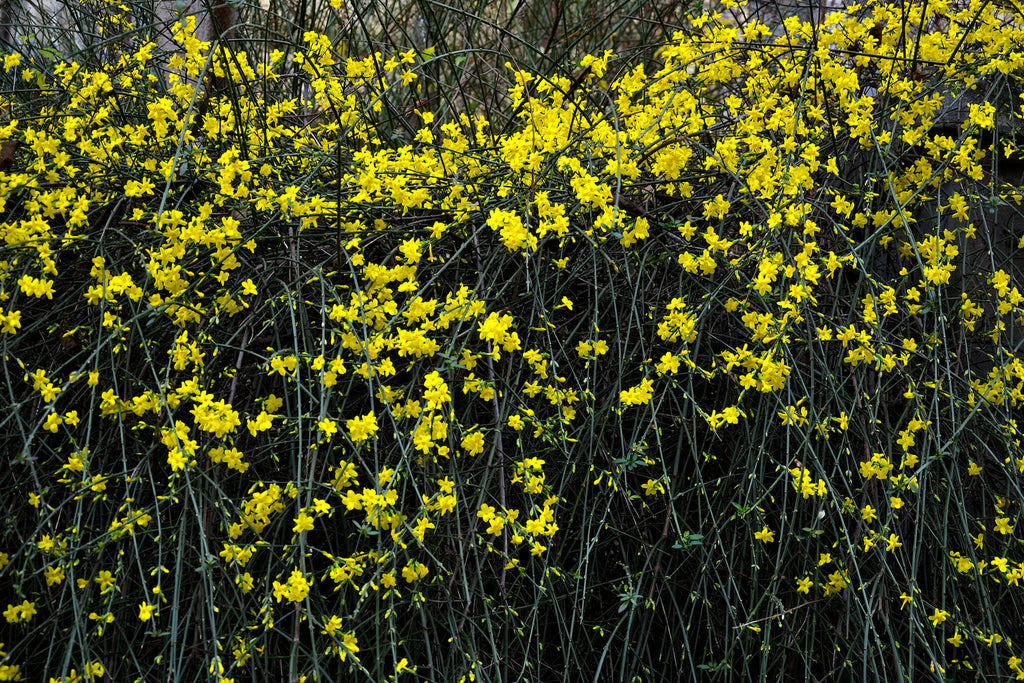
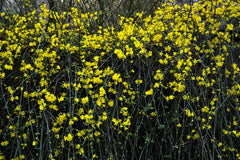
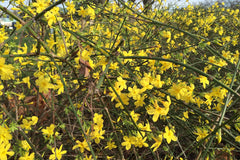
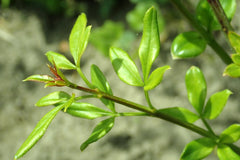
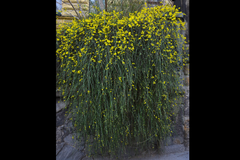
About this cultivar:
Jasminum nudiflorum is a slender, deciduous shrub native to China. Blossoming right after winter, it is aptly named Yingchun, or ‘the flower that welcomes Spring’ in Chinese. In English the common name is ‘Winter Jasmine’. In the Northern Hemisphere, these solitary, bright yellow (or sometimes white) flowers appear on naked stems from November to March. Thus, its epithet, nudiflorum, meaning ‘naked flower’ in latin.
In winter, when all the days seem dark and dreary, these cheerful yellow flowers appear upon bare stems to truly brighten up the space. This sturdy climber is simple to grow, and can be trained on wires or a trellis, but it looks just as attractive when left to meander across low walls. The bright green stems, even in winter, and dark green shoots bring a special charm to this remarkable climber, fully deserving its place in the garden during early spring.
The slim stems also make it fun to grow it though things, perhaps evergreens.
Has the Royal Horticultural Society Award of Garden Merit (RHS AGM).
- Position: Full sun, partial shade
- Soil: Almost any soil, grows well in Ballyrobert
- Flowers: November, December, January, February, March
- Other features: Royal Horticultural Society Award of Garden Merit (RHS AGM), Scented
- Hardiness: Fully hardy, grows well in Ballyrobert, H5 - Hardy in most places throughout the UK even in severe winters (-15 to -10°C)
- Habit: Bushy
- Foliage: Deciduous
- Height: 150 - 250 cm (5 - 8 ft)
- Spread: 150 - 250 cm (5 - 8 ft)
- Time to full growth: 10 to 20 years
- Plant type: Herbaceous Perennial
- Colour: Green, yellow
- Goes well with: -
About this genus:
Jasmine is a genus of around 200 species of shrubs and vines, part of the olive (oleaceae family) mostly prized for their sweet-smelling flowers. Native where? In the subtropical regions of Eurasia, Africa, Australasia, and Oceania, Jasmines have been around since forever. Only one of the two hundred varieties of jasmine can be found in Europe, and they may not even be true natives (whatever Ice age that means…).
The name Jasmin has a long history, beginning with Middle Persian ‘yāsaman’, then passing through Arabic, Ottoman Turkish and Middle French before finally making its way to English in the 16th century then back to botanical Latin and Greek. Quite a journey! Beware tho - there are several unrelated plants with the word 'jasmine' in their names.
As you can imagine with so many species the genus is varied. You can get blooms of white or yellow, sometimes even a bit of red. They can be borne in cymose clusters with a minimum of three flowers, though they can also be solitary on the ends of branchlets. You can get of simple, trifoliate, pinnate, opposing or alternating, leaves. Evergreen or deciduous. Erect, spreading, or climbing. Confusing! But what is normally common across all Jasmine is their sweet fragrant smell. It is only a matter of time before DNA research splits the genus into a million new names for us to remember.
In South Asia and southeast Asia, women wear these blossoms in their hair. In China, jasmine tea is consumed, made with Jasminum sambac flowers and either green, white, or Oolong tea leaves. It takes four hours for the tea to absorb the fragrance and flavour from the flowers, and for the highest grades, the process may be repeated up to seven times.
Jasmine, a flower beloved in so many places, is the national flower of Indonesia, Pakistan, the Philippines, and Tunisia. It's used in wedding ceremonies and religious rituals and is often garlanded and strung up to adorn images of gods. In Thailand, jasmine is a symbol of motherhood. It even has industrial uses, such as for perfumes.
What about in the garden? Well, it is hard to be general with such a large and varied genus, but if you are buying from us we will be selecting a reliable, hardy, easy to grow plant that will probably not be too rampant and perhaps even slow to grow. We have quite heavy wet clay, so they will probably tolerate that for you – and if they tolerate wet clay they will probably tolerate anything else you want to grow them in.

